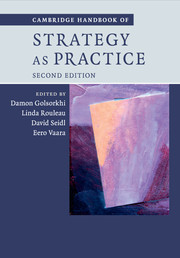Book contents
- Frontmatter
- Contents
- List of figures
- List of tables
- List of boxes
- List of contributors
- Preface to the Second Edition
- Introduction: what is strategy as practice?
- Part I Ontological and Epistemological Questions
- Part II Theoretical Resources: Social Theory
- Part III Theoretical Resources: Organization and Management Theories
- 16 An institutional perspective on strategy as practice
- 17 Relating strategy as practice to the resource-based view, capabilities perspectives and the micro-foundations approach
- 18 Theory of routine dynamics and connections to strategy as practice
- 19 Identity work as a strategic practice
- 20 Sensemaking in strategy as practice: a phenomenon or a perspective?
- 21 The communicative constitution of strategy-making: exploring fleeting moments of strategy
- 22 Analytical frames for studying power in strategy as practice and beyond
- 23 A critical perspective on strategy as practice
- Part IV Methodological Resources
- Part V Substantive Topic Areas
- Index
- References
21 - The communicative constitution of strategy-making: exploring fleeting moments of strategy
from Part III - Theoretical Resources: Organization and Management Theories
Published online by Cambridge University Press: 05 October 2015
- Frontmatter
- Contents
- List of figures
- List of tables
- List of boxes
- List of contributors
- Preface to the Second Edition
- Introduction: what is strategy as practice?
- Part I Ontological and Epistemological Questions
- Part II Theoretical Resources: Social Theory
- Part III Theoretical Resources: Organization and Management Theories
- 16 An institutional perspective on strategy as practice
- 17 Relating strategy as practice to the resource-based view, capabilities perspectives and the micro-foundations approach
- 18 Theory of routine dynamics and connections to strategy as practice
- 19 Identity work as a strategic practice
- 20 Sensemaking in strategy as practice: a phenomenon or a perspective?
- 21 The communicative constitution of strategy-making: exploring fleeting moments of strategy
- 22 Analytical frames for studying power in strategy as practice and beyond
- 23 A critical perspective on strategy as practice
- Part IV Methodological Resources
- Part V Substantive Topic Areas
- Index
- References
Summary
Practice-based approaches in management scholarship and organizational communication studies have in the past mainly evolved along parallel trajectories. Nonetheless, their epistemological and ontological stances – mostly influenced by a pragmatic positioning – and their shared concern for ordinary day-to-day (organizational) practices make them complementary trends of literature that would benefit from a more systematic and engaged dialogue (for similar arguments, see Fenton and Langley 2011; Spee and Jarzabkowski 2011; Vásquez, Sergi and Cordelier 2013). Accordingly, this chapter is a first attempt to put together two bodies of literature, the strategy-as-practice and the communicative constitution of organization approaches – stemming, respectively, from practice-based studies and organizational communication – in order to explore the role of talk and text in strategy-making.
Let us first note that we engage in this dialogue as communication scholars interested in understanding processes of organizing by acknowledging the constitutive force of communication (Putnam and Nicotera 2009). We therefore take a particular point of view for studying organization, more broadly, and here, strategy-making, which is deeply informed by the three following premises: (1) to always start from (rather than arriving at) communication as the motto of every inquiry; (2) to take a broad definition of communication that acknowledges the material and social world in which it takes place; and (3) to account for the many kinds of languages, not only spoken and written, that participate in constituting organization and organizing (Cooren, Taylor and Van Every 2006; see also Cooren et al. 2011).
Applied to the study of strategy and strategy-making, this implies that we should not begin by looking at strategy as originating in the individual and his/her situation and then, subsequently, asking how it gets transmitted in communication. From a communicational approach, we focus on strategy – what it is, what it does – and we question the constitutive role of communication in this being and acting. We also extend this questioning to other forms of communication that do not pertain solely to human activity; texts, objects, architectural elements, as we will argue, also ‘communicate’, and thus take part in the making of strategy. Finally, while accounting for the key role of language as talk and text, we do not exclude other modes of communication, such as paralinguistic or non-human modalities, that can also allow us to fully explore how communication constitutes strategy.
- Type
- Chapter
- Information
- Cambridge Handbook of Strategy as Practice , pp. 365 - 388Publisher: Cambridge University PressPrint publication year: 2015
References
- 23
- Cited by

